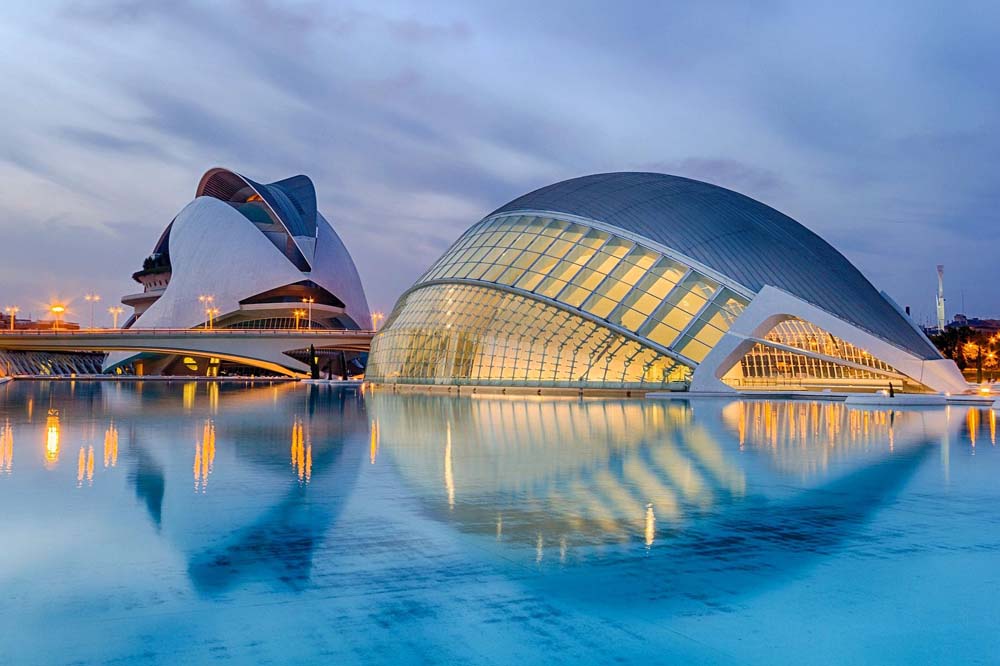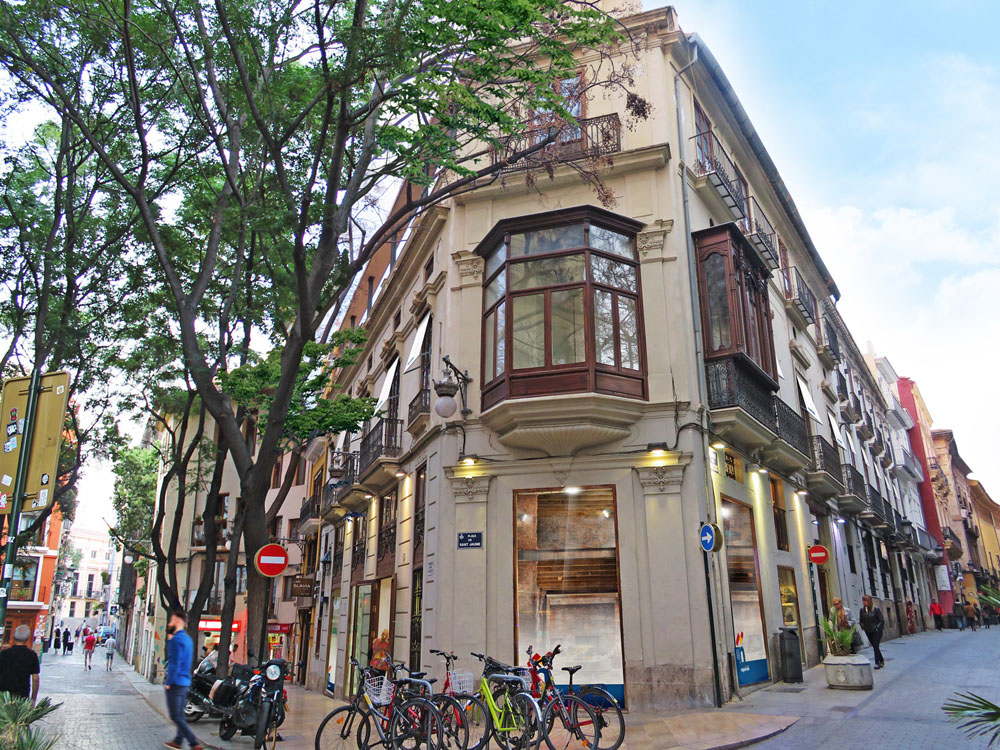Overview
A worthy rival to Madrid and Barcelona, Valencia is the third largest city in Spain and one of the most important in the Mediterranean. Until a few years ago, it was a place visited only by the most seasoned travelers, but after the America’s Cup, Valencia became famous all over the world, with apparent results on the architecture, organization of the city, and the number of tourists. As was the case for the Olympic Games in Barcelona, this event also gave new life to Valencia, creating a mix of creativity and energy that contributed to the Valencian explosión.
Language Schools and Camps in this Destination
In Valencia, Marshall Language Services also offers Spanish courses through the following language schools:
- Taronja School
- Don Quixote Valencia
Images of Valencia, Spain
Things to Do and See During a Vacation Study
The Cathedral of Valencia
The baroque Puerta del Los Hierros, the Romanesque Puerta del Palau and the Gothic Puerta de los Apostoles are the three access gates to the Cathedral of Valencia, and comprise a summary of the city’s architectural history. Built in the 13th century, the Cathedral stands in a “sacred” place in which there had previously been a Roman temple and then a Muslim mosque. The visit should begin with the Miguelete, the tower that overlooks the Cathedral, and which offers a view of the entire historic center. However, what most attracts tourists is the Holy Grail: the Chalice that Jesus supposedly used at the Last Supper, and which is kept inside the Cathedral.
The City of Arts and Sciences
The plan for this enormous complex, an important example of modern architecture, is the merit of the architect Santiago Calatrava. The City of Arts and Sciences contains five spectacular attractions: the Oceanografic, the Umbracle, the Palace of Arts, the Science Museum and the Hemisfèric. In a predominance of white material, each element that makes up the City of Sciences is built in a different style, but which create a perfect harmony of the whole.
The Barrio del Carmen
Located around the convent of Carmen Calzado, the Barrio del Carmen, in the course of its thousand-year history, has played different roles: from shelter, to barracks, to a place of prostitution in the center of the medieval aristocracy, until it became working class in the 1900s. Today, it is one of the busiest places in the city, both by day than by night. In the morning it is great for shopping, with its independent shops and name-brand boutiques, and at night is a favorite for young people who come to relax after a day of study or work.
The Lonja de la Seda
La Lonja de la Seda (Silk Market) was originally a symbol of the golden age of Valencia, a center of commercial and cultural activities in the early 16th century. In 1996, it was declared a World Heritage Site by UNESCO, as one of the most beautiful and best preserved examples of late Gothic architecture in Europe. La Lonja is now home to the Cultural Academy of Valencia, and often the venue for exhibitions, as well as an obligatory stop during a visit to the city.
The Central Market of Valencia
Opposite the magnificent building of the Lonja stands a steel structure, with stained glass windows and hand-painted ceramics on the facade: it is the Central Market, with its 959 banks of fresh products. It is a veritable intertwining of colors, smells and tastes in a jewel of modern architecture. The Market is divided into two parts: on one side there are fruit and vegetables from the Valencian huerta (area of agricultural lands south of Valencia) and on the other, a large assortment of meat, including Salamanca hams and fish.
The Turia Gardens of Valencia
Valencia is an example of a city built along the banks of a river. The Turia River, on the one hand, has encouraged the development of urban settlement, but on the other, was the cause of continuous flooding. After the last flood of 1957, the authorities decided to deviate the course of the river, and where the riverbed was located, the Turia Gardens are now. They are an oasis of greenery and peace in the city center. Visitors can spend their free time among pines, oleanders and palms, jog through the avenues or take advantage of one of the sports facilities that the Gardens offer. The main attraction of the park is a monumental sculpture of Gulliver, 70 meters long, inspired by the character of Jonathan Swift. Ramps, slides and stairs allow the “Lilliputians” (i.e. visitors), to walk on the body of the giant.
The Biopark of Valencia
The Valencia Biopark is much more than a traditional zoo. It is an innovative project, in which the animals live in social groups, without a separation from other species, just as in nature. The park is divided into 3 large areas: the African savannah, the equatorial forests of Africa and Madagascar, and the African wetlands. Visitors can walk in these areas, observing animals freely but in complete safety. Lions, leopards, giraffes, gorillas, rhinos, hippopotamuses, elephants, lemurs and many other animals can be seen the park.
The port, the beaches and the Valencia Reserve
After decades in which the port and industrial activities had created disasters, Valencia transformed the sea and the beaches. The port area, now called Marina Real Juan Carlos I, has been redeveloped. From the “Veles e Vents” building, visitors can admire a splendid view of the sea, and enjoy the sun in complete relaxation. From here a nice walk along the promenade leads to the beaches of Les Arenas and Malvarrosa with clear waters that have been awarded a European Blue Flag. For nature lovers, the Albufera Reserve, the largest lake in Spain, is not far from there.
How to Arrive at your Language Course
By Air
Valencia Airport (VLC) – 9 km from Valencia city center
Public transportation to city center:
Train every 10 minutes, journey time 20 minutes.
Bus every 15 minutes, journey time 45 minutes.
Direct international flights from:
Italy: Bari, Bologna International, Milan Bergamo, Pisa, Rome Ciampino, Rome Fiumicino, Trieste, Turin, Venice Treviso
Ireland: Dublin
United Kingdom: East Midlands, London Gatwick, London Stansted, Manchester
Alicante Airport (ALC) – 132 km from Valencia city center
Public transportation to city center:
Train every 20 minutes, journey time 180 minutes.
Bus every 20 minutes, journey time 230 minutes.
Direct international flights from:
United Kingdom: Belfast City, Belfast International, Birmingham, Bournemouth, Bristol, Cardiff, Doncaster Sheffield, East Midlands, Edinburgh, Exeter, Glasgow International, Glasgow Prestwick, Leeds Bradford, Liverpool, London City, London Gatwick, London Luton, London Southend, London Stansted, Manchester, Newcastle, Norwich, Southampton
Italy: Bologna International, Milan Bergamo, Milan Malpensa, Rome Fiumicino, Venice Marco Polo
Ireland: Cork, Dublin, Kerry, Knock, Shannon



